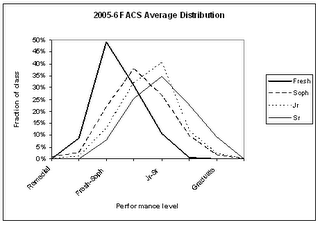We now have three years' data on our general education assessment model. You can read about it in great detail in
Assessing the Elephant. I have so far focused on checking the validity of the data to see if it actually means anything. I'm beginning to think it does. Here's a graph showing the distribution of scores over time as a class ages.

The data here aren't truly longitudinal--it's a composite of three classes to give a good sample size and show performance shifts over four years. A similar approach compares students based on their overall grade point averages. All students in these data sets were still attending as of Spring 2006, so survivorship issues are controlled for.

Here you can see that the better students actually seem to be learning. The middle class of students learns more slowly, and the students with GPA < 2 don't seem to be improving at all. These studies and others seem to validate our approach. The holy grail of this investigation is to be able to pinpoint the contribution of individual courses to a student's skill improvement. I've worked on that quite a bit but have concluded that I don't have enough samples yet, and I haven't developed a sophisticated enough approach to the problem. Stay tuned.
 The data here aren't truly longitudinal--it's a composite of three classes to give a good sample size and show performance shifts over four years. A similar approach compares students based on their overall grade point averages. All students in these data sets were still attending as of Spring 2006, so survivorship issues are controlled for.
The data here aren't truly longitudinal--it's a composite of three classes to give a good sample size and show performance shifts over four years. A similar approach compares students based on their overall grade point averages. All students in these data sets were still attending as of Spring 2006, so survivorship issues are controlled for. Here you can see that the better students actually seem to be learning. The middle class of students learns more slowly, and the students with GPA < 2 don't seem to be improving at all. These studies and others seem to validate our approach. The holy grail of this investigation is to be able to pinpoint the contribution of individual courses to a student's skill improvement. I've worked on that quite a bit but have concluded that I don't have enough samples yet, and I haven't developed a sophisticated enough approach to the problem. Stay tuned.
Here you can see that the better students actually seem to be learning. The middle class of students learns more slowly, and the students with GPA < 2 don't seem to be improving at all. These studies and others seem to validate our approach. The holy grail of this investigation is to be able to pinpoint the contribution of individual courses to a student's skill improvement. I've worked on that quite a bit but have concluded that I don't have enough samples yet, and I haven't developed a sophisticated enough approach to the problem. Stay tuned.







No comments:
Post a Comment